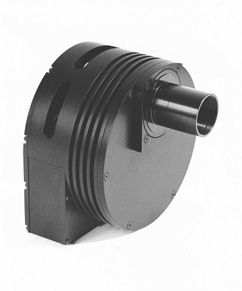 |
ST-8XE CCD IMAGING |
| CCD Imaging Cameras | ST-402ME | ST-7XE | ST-8XE | ST-9XE | ST-10XE | ST-2000XM | NEW Large Format Cameras | |
| Video Camera / Autoguider |
|
|||||||
| Industrial / Scientific | ||||||||
MODEL ST-8XE/XME |
 |
ST-8XE CCD IMAGING |
The
Model ST-8XE is identical to the Model ST-7XE except that it is furnished with a 4x larger
imaging CCD detector and 2.7X larger tracking CCD. The imaging CCD has a Full Frame
Resolution of 1530 x 1020 pixels at 9 microns square and the tracking CCD has 657 x 495
pixels at 7.4 microns square. Since the ST-7XE and ST-8XE imaging CCD detectors are
pin to pin compatible, SBIG designed the CCD head to accept either detector. As a result
the Model ST-7XE is easily upgraded to the Model ST-8XE. The large CCD active area of 13.8
x 9.2 mm allows the user to image large fields of view with the ST-8XE. The various
binning modes of 9, 18, and 27 micron pixels allows the user to match the focal length of
a wide range of telescopes and lenses to this imaging camera. The imaging camera includes
an electro-mechanical shutter, 16-bit analog to digital (A/D) converter, regulated
temperature control with all of the electronics integrated into the CCD head.
Communication to the PC is through the USB port. The Full Frame download time is
approximately 3.7 seconds, nearly 14 times faster than the previous parallel port version
of this camera. The image update rate in focus mode is approximately 2 frames per
second.
![]() May 2004: The ST-8XE
is now available with the new KAF-1603ME CCD from Kodak. This latest version of the
CCD uses the same microlens technology that has met with much success on the ST-10XME and
ST-7XME cameras. Click here for more information on the ST-8XME.
Other than the QE, please note that all the specs below are the same.
May 2004: The ST-8XE
is now available with the new KAF-1603ME CCD from Kodak. This latest version of the
CCD uses the same microlens technology that has met with much success on the ST-10XME and
ST-7XME cameras. Click here for more information on the ST-8XME.
Other than the QE, please note that all the specs below are the same.
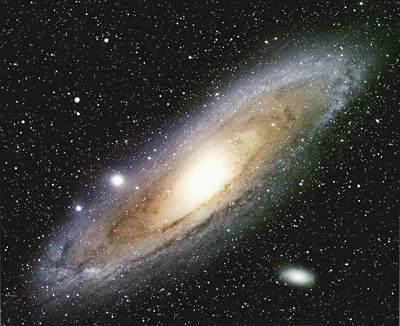 |
M31. ST-8E two image mosaic of
Andromeda galaxy taken through |
SBIG
actively encourages wide field imaging with the Model ST-8XE. We offer Camera Lens
Adapters (CLA-7) to attach standard camera lenses to the imaging camera. In wide field
imaging the ST-8XE, CLA-7 and camera lens are typically mounted piggyback on the primary
telescope, which acts as a guiding platform. The ST-8XE is set for the high resolution (9
x 9 micron) pixel mode to match the short focal lengths of the camera lens. SBIG has
received wide field customer images with 4 to 5 degrees field of view showing large
extended objects with much detail and structure. Wide field imaging (i.e., f/2 to f/4) is
easy to do, as locating objects becomes a relatively simple matter and guiding is much
less critical at the short focal lengths of 100 to 400 mm. We urge our customers to try
this technique with both Models ST-7XE and ST-8XE.
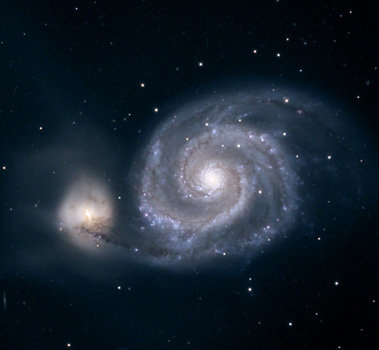 |
| M51. Model ST-8E image of the Whirlpool
Galaxy taken through a 12.5" f/6.7 telescope. Courtesy William McLaughlin |
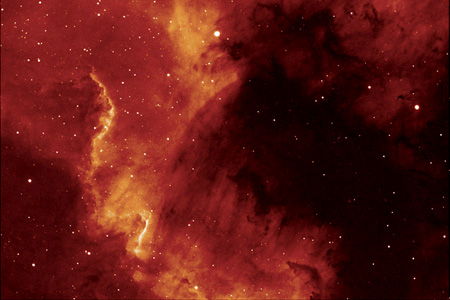 |
| NGC 7000. A portion of the North American nebula was
captured with 5" f/6 telescope using an ST-8 camera equipped with an H-alpha filter . Three 20 minute frames were averaged to create this false color image. Courtesy Brad Ehrhorn |
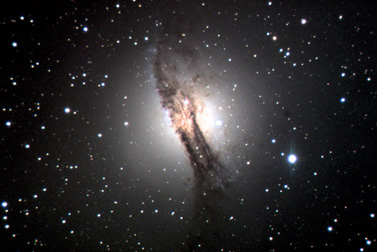 |
| NGC 5128. This ST-8E image of Centarus A ws taken
through a C14 telesocpe at f/11. Courtesy Peter Ward |
In its price range, the Model ST-8XE is unmatched in
resolution, performance, low noise and field of view in the amateur astronomy market and,
therefore, is widely used in astronomy for high resolution imaging and wide field searches
for near earth asteroids, comets, supernova, etc. The dual CCD structure allowed SBIG to
design an Adaptive Optics System to work in conjunction with the ST-8XE and other
self-guiding cameras in the ST line. This unique system is described under the
Accessory Products section of this catalog.
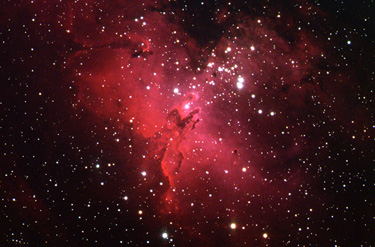 |
| M16. ST-8 image of the Eagle Nebula taken through a
7" f/9 telescope using a CFW8 filter wheel and AO-7 adaaptive optics device. Each RGB image was guided at 10 corrections per second. Courtesy David Hanon. |
Model ST-8XME
Typical Specifications
CCD Specifications
| ST-8XME CCD | Kodak KAF-1603ME + TI TC-237 |
|---|---|
| ST-8XME CCD | Kodak KAF-1603ME + TI TC-237 |
| Pixel Array | 1530 x 1020 pixels, 13.8 x 9.2 mm |
| Total Pixels | 1,500,000 |
| Pixel Size | 9 x 9 microns |
| Full Well Capacity ABG | ~50,000 e- |
| Full Well Capacity NABG | ~100,000 e- |
| Dark Current | 1e¯/pixel/sec at 0° C |
| Antiblooming | KAF-1603ME is NABG only ABG optional (KAF-1602LE) |
Readout Specifications
| Shutter | Electromechanical |
|---|---|
| Exposure | 0.11 to 3600 seconds, 10ms resolution |
| Correlated Double Sampling | Yes |
| A/D Converter | 16 bits |
| A/D Gain | 2.5e¯/ADU |
| Read Noise | 15e¯ RMS |
| Binning Modes | 1 x 1, 2 x 2, 3 x 3 |
| Pixel Digitization Rate | Up to 420,000 pixels per second |
| Full Frame Acquisition | 3.7 seconds |
Optical Specifications (8" f/10)
| Field of View | 24 x 16 arcminutes |
|---|---|
| Pixel Size | .9 x .9 arcseconds |
| Limiting Magnitude | Magnitude 14 in 1 second |
| (for 3 arcsec FWHM stars) | Magnitude 18 in 1 minute |
System Specifications
| Cooling - standard | Single Stage Thermoelectric,
Active Fan, Water Assist Ready -45 C from Ambient Typical |
|---|---|
| Temperature Regulation | ±0.1°C |
| Power | 5 VDC at 1.5 amps, ±12 VDC at 0.5 amp Desktop Power Supply Included |
| Computer Interface | USB |
| Computer Compatibility | Windows 98/2000/Me/NT/XP |
| Guiding | Dual CCD Self-Guiding |
Physical Dimensions
| Optical Head | 5 inches diameter x 3 inches 12.5 cm diameter x 7.5 deep 2.2 pounds/1 Kg |
|---|---|
| CPU | All electronics integrated into Optical Head, No CPU |
| Mounting | T-Thread, 1.25" and 2" nosepieces included |
| Backfocus | 0.92 inches/2.3 cm |
Price
Price and specifications subject to change without notice
Revised: February 10, 2005 03:06:55 PM.
Copyright © 1998 Santa Barbara Instrument Group, Inc. All rights reserved.
Please report any problems with this page directly to the Webmaster